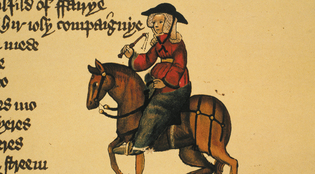 loading
loading
FindingsThe war between the sexes, in the Middle AgesNot everyone believed the “Book of Wikked Wyves.”  Bridgeman Art LibraryIn the Canterbury Tales, the Wife of Bath describes her husband's collection of misogynistic screeds. It turns out to have been based in reality. View full image
How misogynistic were Englishmen in the Middle Ages? Not as much as you might think. A retired Yale Chaucer scholar is bringing to press several medieval tracts by men about women—and while some pass harsh judgment, others deliver surprisingly spirited defenses. In the Canterbury Tales, the Wife of Bath describes her husband’s collection of misogynistic screeds. It turns out to have been based in reality.
The book, due out in 2013, will be the second volume of Jankyn’s Book of Wikked Wives (University of Georgia Press). Both the title and the research were inspired by Chaucer. In the Canterbury Tales, the Wife of Bath says that Jankyn, her fifth husband, used to read to her nightly from his “Book of Wikked Wyves”—a collection of misogynistic screeds about wives who made their husbands’ lives miserable. The 2013 book will be the culmination of 80 years of on-again, off-again investigation into Jankyn’s (fictional) book and the real collections Chaucer based it on. Yale Chaucerian Karl Young began the project in the 1930s, and his student, Robert Pratt ’29, ’33PhD, continued it. Traugott Lawler, professor emeritus of English, and Ralph Hanna ’66PhD, now at Oxford, took over the project from Pratt in 1981. It is their work that will soon be published. By combing through English libraries, Young and Pratt found a number of ancient “books of wikked wyves,” that is, collections of writings that criticize women and warn men against marriage. Their discoveries make it clear that although much of Jankyn’s book is “Chaucer’s fantastic idea,” says Lawler, “such collections actually existed.” The main text in these collections—and Jankyn’s favorite—is the Dissuasio Valerii, a witty attempt by a character named Valerius to dissuade a friend from marrying. (Young and Pratt began the work of preparing the Dissuasio for print, along with the other main texts mentioned by the Wife of Bath. Lawler and Hanna completed it for the first volume of Jankyn’s Book, published in 1997.) The actual author of the Dissuasio was Walter Map, a late-twelfth-century cleric and courtier. Map was a satirist, and his disparagement of women and matrimony, says Lawler, was “largely tongue in cheek.” But readers took the book seriously: it was taught in schools and became the subject of learned commentaries. Young and Pratt uncovered these commentaries, seven in all, and Lawler and Hanna have now edited and translated them for print. Interestingly, none of the commentators caught Map’s irony. Four of them take him at his word, but three treat his advice as “a dangerous text to be refuted,” Lawler says; they insist that marriage is good and women are good. That gives them a significance beyond Chaucer scholarship, he notes. “These three precious texts offer vigorous defenses of women,” and are therefore “significant new voices from the medieval world arguing for common sense in the relationship between the sexes.”
The comment period has expired.
|
|